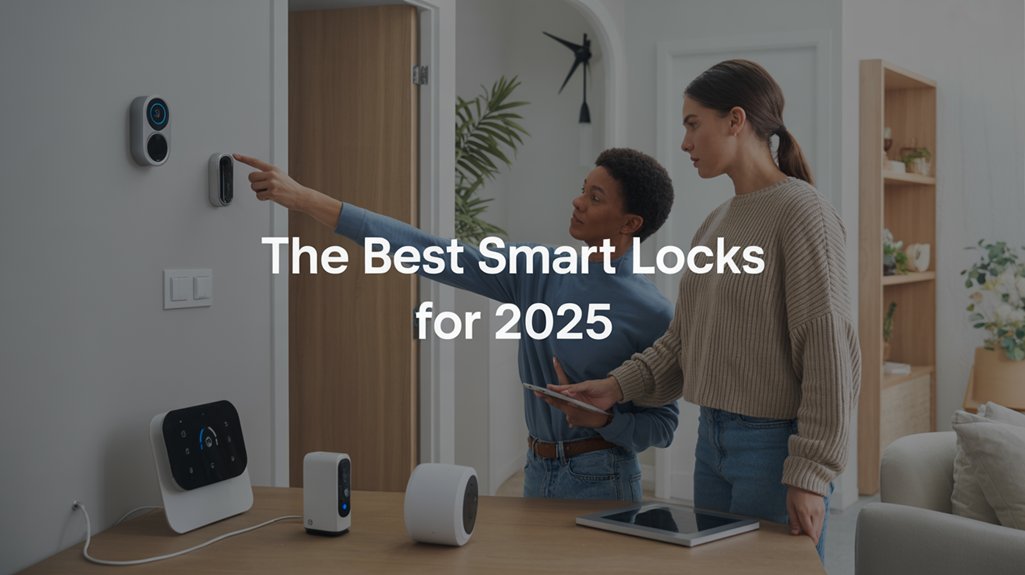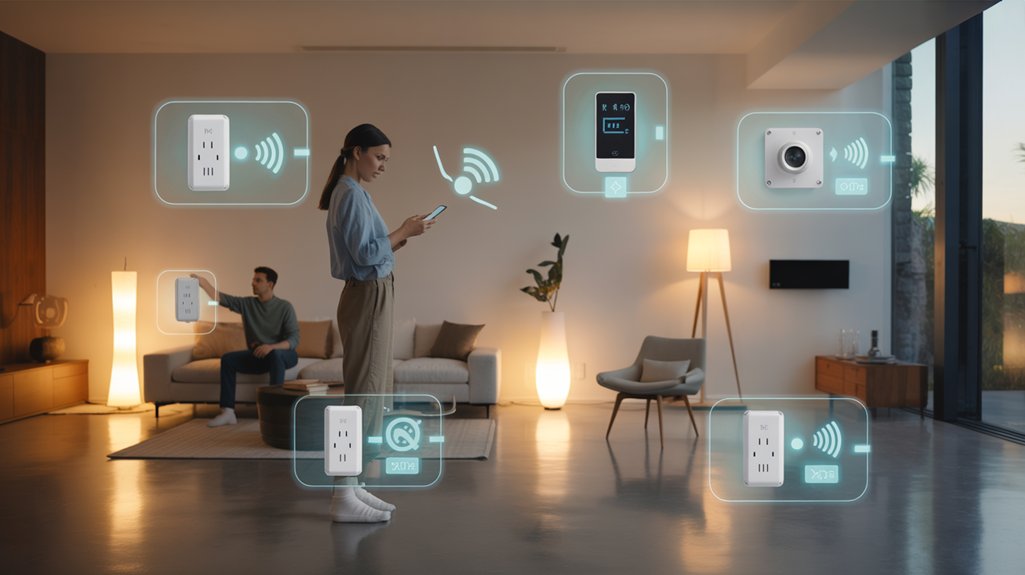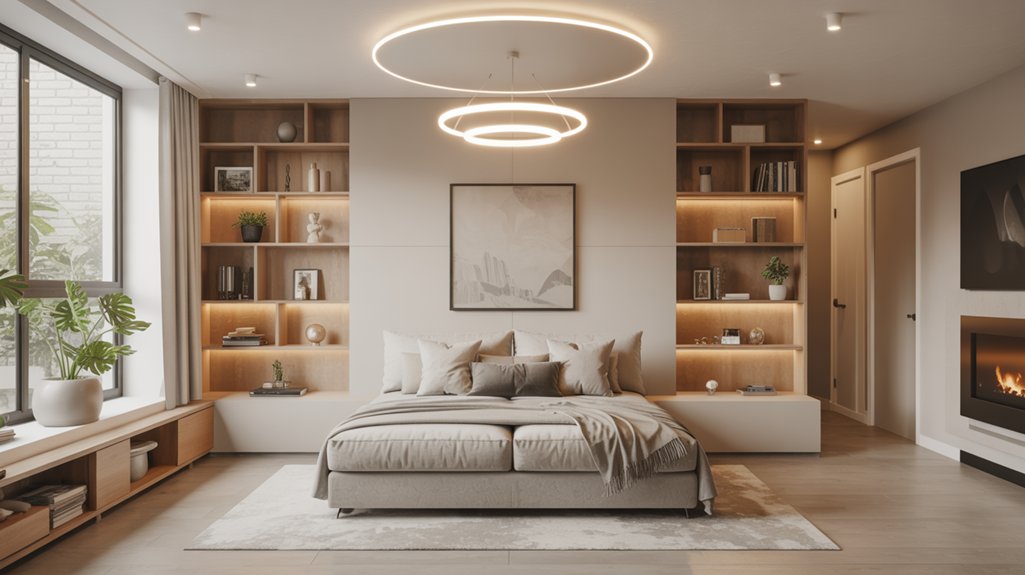You’ll find the Yale Assure Lock 2 leads 2025’s smart lock market with Apple Home Key integration and premium construction, while Wyze Lock Bolt offers budget-friendly fingerprint access. August’s Wi-Fi model simplifies installation by keeping your existing deadbolt, and Lockly Vision Zeno combines 2K camera monitoring with multiple authentication methods. Essential features include 9V emergency backup ports, reliable Bluetooth connectivity, and proper strike plate reinforcement for break-in resistance. Understanding installation requirements and backup access methods ensures optimal security performance.
Key Takeaways
- Yale Assure Lock 2 leads with premium materials and Apple Home Key integration for seamless iPhone unlocking.
- Wyze Lock Bolt offers budget-friendly fingerprint access while August Wi-Fi simplifies installation using existing deadbolts.
- Lockly Vision Zeno combines 2K camera monitoring with multiple access methods and eight-month battery life.
- Wi-Fi connectivity enables remote access without bridges, while Bluetooth-only options reduce security vulnerabilities but limit features.
- All models include 9V emergency backup ports and traditional key access to prevent lockouts during power failures.
Top Smart Lock Models and Key Features
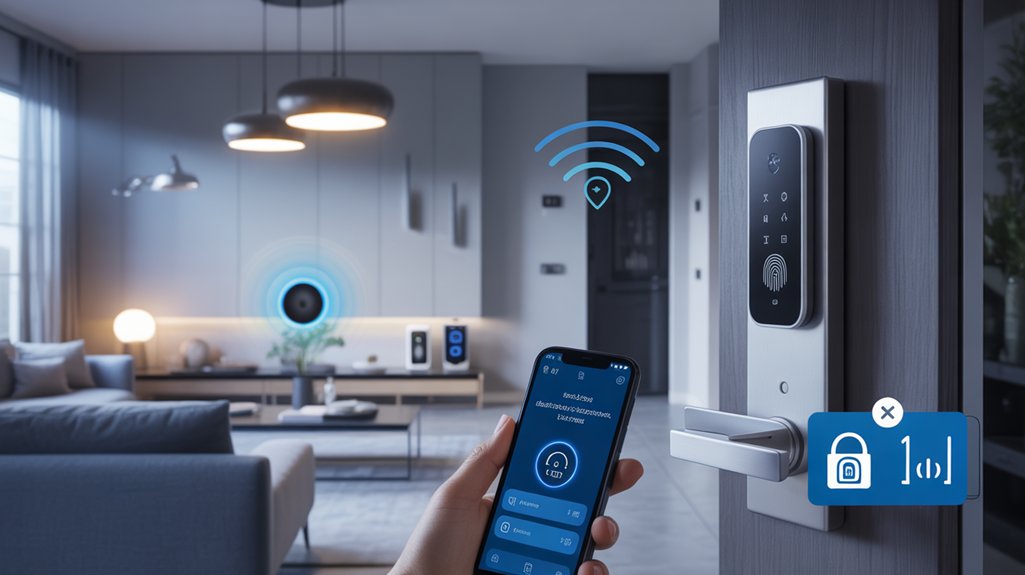
Which smart lock delivers the security and convenience you need without compromising your home’s protection? Your choice depends on balancing features against installation complexity and long-term reliability. The Yale Assure Lock 2 sets the tone setting with premium materials and Apple Home Key integration, while Wyze Lock Bolt offers budget-conscious fingerprint access. August’s Wi-Fi model simplifies installation by retaining your existing deadbolt. For comprehensive security, Lockly Vision Zeno combines 2K camera monitoring with multiple access methods. Each model requires ethics compliance with local building codes and proper installation to maintain your home’s structural integrity and insurance coverage. Consider integrating your smart lock with smart lighting systems to create a cohesive home security ecosystem that enhances both convenience and protection.
Access Methods and Security Options
How do you access your smart lock when your smartphone battery dies or the fingerprint scanner fails? Smart locks provide multiple backup methods to prevent lockouts. Traditional keyed entry remains your most reliable fallback, while 9V battery terminals let you power dead electronic locks during emergencies. Without getting into subtopic irrelevance, your primary access methods include Bluetooth apps, fingerprint sensors, keypads, and physical keys. When integrated with Apple’s ecosystem, smart locks can be managed through the Home app alongside other security accessories for centralized control.
Smart locks offer multiple backup access methods including physical keys, 9V battery terminals, and keypads to prevent emergency lockouts.
- Dead smartphone leaving you stranded at your front door during a rainstorm
- Fingerprint scanner covered in paint after weekend home projects
- Power outage disabling your lock’s electronic components
- Guests arriving when your Wi-Fi network experiences an off topic tangent disruption
Connectivity and Smart Home Integration
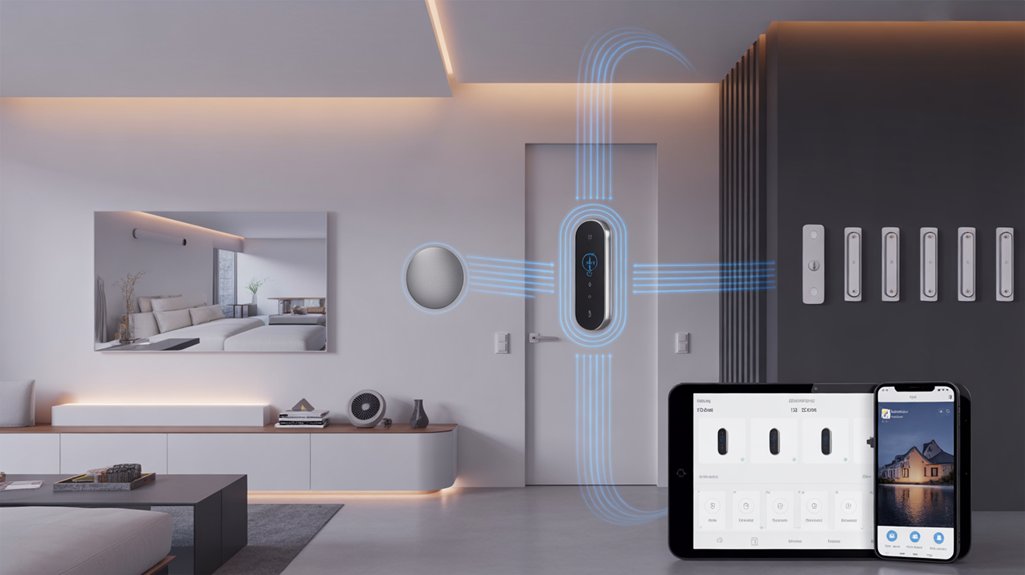
Beyond ensuring you can physically unlock your door, your smart lock’s connectivity determines how effectively it integrates with your existing smart home ecosystem and remote monitoring needs. Wi-Fi-enabled models like the August Smart Lock eliminate bridge requirements, directly connecting to your network for seamless automation with Alexa, Google Assistant, and Apple HomeKit. Bluetooth-only options limit remote access but reduce potential security vulnerabilities. Consider your home’s layout—thick walls can disrupt signals, creating untapped markets for mesh network solutions. While connectivity might seem like an unrelated topic to physical security, wireless reliability directly impacts your lock’s core functionality and emergency access capabilities.
Installation and Design Considerations
Where your smart lock mounts determines both its vulnerability and your daily convenience, making installation methodology a critical security decision rather than mere aesthetics. Modern smart locks prioritize compact packaging to minimize visual intrusion while maximizing tamper resistance. Matte finishes reduce fingerprint visibility and weather exposure markers that signal usage patterns to potential intruders.
Smart lock placement isn’t about looks—it’s a strategic security choice that impacts both protection and everyday usability.
- Reinforced strike plates distribute force across door frames during attempted break-ins
- Beveled edges prevent crowbar leverage points that compromise traditional deadbolts
- Recessed mounting hardware eliminates accessible screws from exterior surfaces
- Low-profile designs reduce visual targets while maintaining structural integrity against forced entry
Battery Life and Power Management
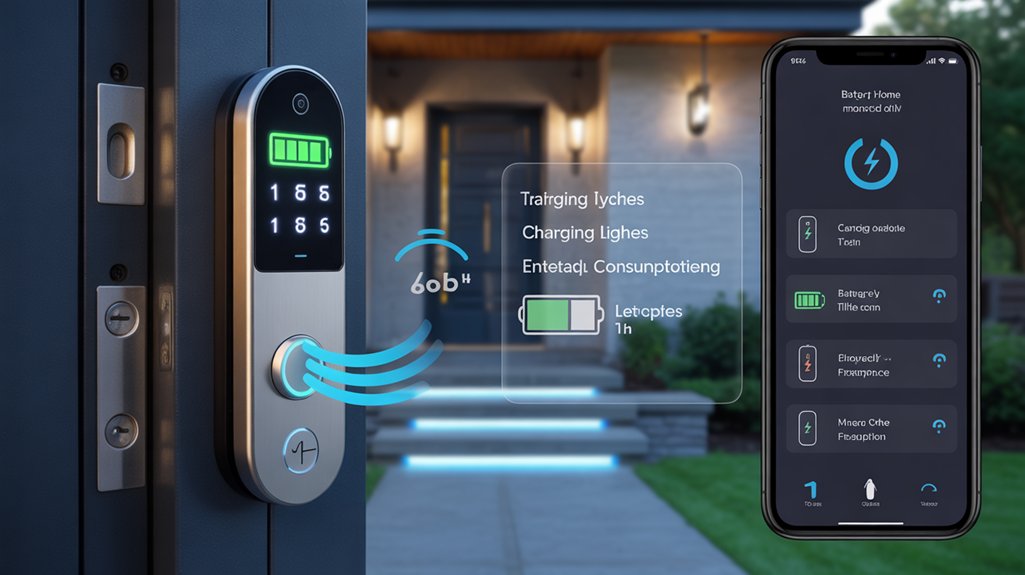
Since smart locks defend your home’s primary entry point, their power systems must operate reliably through extended outages, seasonal temperature extremes, and the inevitable neglect of maintenance schedules. Battery optimization becomes critical when you’re managing multiple wireless radios—Bluetooth, Wi-Fi, and Z-Wave simultaneously drain power reserves. The Lockly Vision Zeno’s eight-month lifespan with dual rechargeable batteries demonstrates superior power budgeting compared to models requiring frequent AA replacements. You’ll want locks offering 9V emergency backup ports for dead-battery scenarios. Monitor your lock’s battery levels through companion apps, and consider models with low-power standby modes that preserve charge during extended vacations.
Frequently Asked Questions
What Happens to My Smart Lock During Extended Power Outages or Internet Failures?
During extended power outages, you’ll rely on your smart lock’s 9V battery backup to maintain basic functionality, though app connectivity disappears without internet. Most locks retain fingerprint and keypad access, but you’ll lose remote monitoring capabilities during internet failures. Weather exposure can accelerate battery drain, potentially affecting your insurance coverage if security’s compromised. You should install fresh backup batteries before severe weather and keep traditional keys accessible as your primary failsafe method.
Can Smart Locks Be Hacked and How Do I Protect Against Security Breaches?
Don’t put all your eggs in one basket—smart locks can be hacked through security flaws in Wi-Fi connections, Bluetooth vulnerabilities, or weak passwords. Your mitigation strategies should include enabling two-factor authentication, regularly updating firmware, using strong unique passwords, and choosing locks with encrypted communication protocols. Models like Yale Assure Lock 2 offer robust security features, while proper installation ensures optimal protection against potential breaches targeting your home’s entry points.
Are Smart Locks Weatherproof Enough for Harsh Winter or Summer Outdoor Conditions?
Most smart locks offer adequate weatherproof durability for typical outdoor installation, but you’ll need to verify IP ratings and operating temperature ranges for your specific climate. Extreme conditions can affect battery performance and electronic components. You should install protective overhangs or covers in harsh environments, regularly maintain seals, and choose models rated for your local temperature extremes. Always check manufacturer specifications before outdoor installation to ensure reliable operation year-round.
What’s the Typical Lifespan of a Smart Lock Before Needing Replacement?
You’ll typically get 5-7 years from a quality smart lock before replacement becomes necessary. Lifespan expectations depend heavily on your installation quality, environmental exposure, and usage frequency. Battery-powered models require replacements every 8-12 months, while mechanical components face wear from daily cycling. Two word discussion ideas include “component degradation” and “firmware obsolescence” – both critical factors. Poor installation accelerates failure, while extreme temperatures and moisture exposure significantly reduce operational longevity.
Do Smart Locks Void My Home Insurance or Affect Coverage Claims?
Smart locks typically don’t void your home insurance, but you’ll need to verify coverage specifics with your provider. Insurance implications vary by carrier—some may require notification of security system changes, while others offer discounts for enhanced protection. Proper installation affects loss coverage eligibility, so you’ll want professional setup or documented DIY compliance. Review your policy’s security equipment clauses and contact your insurer before installation to ensure you’re maintaining full coverage protection.
Conclusion
Remember, you’re only as secure as your weakest link—and that’s often your front door. You’ll want to prioritize locks with encrypted communication, backup power systems, and proven reliability records over flashy features. Don’t overlook your existing door’s structural integrity during installation, as even premium smart locks won’t compensate for weak frames or worn hardware. Test your chosen model’s connectivity range and backup access methods before you’re locked out during a power outage or network failure.

